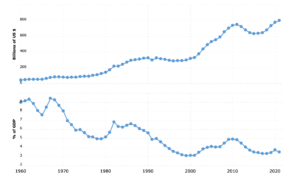Postcards from the florida republic: An independent and profitable state of mind.
You’ve got to hand it to the Keynesian economists. Every chance they get, they’ll spend money we don’t have and praise themselves for doing it. Last week, it was these White House economists writing a paper to celebrate record government spending.
This week, it’s Treasury Secretary Janet Yellen.
 In a recent “trip” to China, Yellen reportedly dined on jian shou qing psychedelic mushrooms, a Yunnanese delicacy.
In a recent “trip” to China, Yellen reportedly dined on jian shou qing psychedelic mushrooms, a Yunnanese delicacy.
Not long after, she argued the best course of action for the global economy is for the United States and other nations to keep sending money to Ukraine. Of course, she said that it would be great to end the war - but the war is good for the economy. It’s a never-ending commitment to the “broken window” fallacy of her economic ideology. Break things, replace things, then brag about economic growth (despite the glaring inefficiencies of resource use).
Today, we must look at the obvious outcome. This war will extend into 2024. It will be used as an excuse to keep pumping money to Ukraine, even while the streets of Philadelphia look more and more like actual warzones.
If you want the stone-cold truth.
There’s money in this ugly side of humanity - the things that Yellen and our government continue to embrace.
War: A For-Profits Industry
The United States has been in a perpetual state of war and conflict since the 1960s.
Each year, the amount of money spent at the Pentagon rises higher and higher. The U.S. government will continue to exert military pressure around the globe. In 2023, the United States allocated more than $800 billion for its global defense operations. In 2024, the U.S. Defense Department could see its budget rise to a whopping $886 billion.
Even though many people want world peace, we have yet to achieve it.
Money’s always involved in war, defense, and other unpleasant things happening worldwide. Right now, the United States is engulfed in a series of rising geopolitical tensions.
In 2023, the U.S. military supported Ukraine in a proxy war against Russia. The U.S. has shipped billions of dollars in military equipment, including arms, missiles, and tanks. If Yellen had her way, we’d double the money we’re sending to Europe. Meanwhile, the Pentagon just called up reservists in what could be a signal for further escalation.
Meanwhile, the U.S. continues to face superiority challenges from China in the Pacific. The nation has invested billions into cybersecurity, hypersonic missiles, and other advanced technologies as the U.S. and China ratchet up tensions across the Pacific.
But those are not the only theaters in which the U.S. operates.
We maintain heightened tensions with North Korea… and we
remain on heightened guard in the Middle East after a 20-year occupation in Afghanistan ended in fiasco in 2021.
 Over the last 20 years, the United States military budget has increased by hundreds of billions. Although military spending represents a smaller share of GDP than in 2010 (3.5% today compared to 5% then), investors should anticipate the Pentagon will continue to spend a hefty amount of taxpayer dollars next year… and in the decades ahead.
Over the last 20 years, the United States military budget has increased by hundreds of billions. Although military spending represents a smaller share of GDP than in 2010 (3.5% today compared to 5% then), investors should anticipate the Pentagon will continue to spend a hefty amount of taxpayer dollars next year… and in the decades ahead.
The chart to the right shows how the annual U.S. military spending has roughly doubled over the last 15 years. Don’t expect this trend to subside in the future.
$68 Billion in Revenue… Another $180 Billion in the Back Pocket
Investors looking to tap into the long-term trend of U.S. and global defense must look at Raytheon Technologies (RTX). The product of a 2017 merger between Raytheon and United Technologies, the company generates more than $68 billion in annual revenue.
The reason I’m telling you this today: Raytheon will change its name to RTX Corporation. The change, announced this morning, will take effect on July 28. The company will keep the ticker RTX.
RTX maintains a massive backlog of projects worth $180 billion.
While only $71 billion of those projects are defense-oriented, the company will make the balance on large-scale commercial projects. As previously noted, the Pentagon is seeking a big boost to global defense spending—a whopping $886 billion in taxpayer money. Many of the products that the Pentagon is seeking to increase spending around are Raytheon designs.
Raytheon is getting paid for its F-35 program. It manufactures numerous parts for the F-35 platform. To put into perspective how lucrative this contract is, consider that the F35 program doesn’t sunset until the year 2070.
The company produces the PATRIOT missile, which is quite popular in today’s conflicts and is leading in the race for hypersonic missiles (the face of future warfare). The company also produces the Javelin Weapon System, which has been essential in the ground war in Ukraine to target Russian tank systems.
Raytheon is one of many U.S. military companies with wide reach around the globe. Although many options exist, investors should focus on the current conflicts and the longevity of weapons programs as a means of investment selection. Raytheon recently pulled back under $100 per share and traded below its long-term price-to-earnings ratio. Investors should buy and buy with confidence. In addition, RTX pays a reliable dividend of 2.4% and has consistently raised its dividend each year for 25 years.
Raytheon Technologies (RTX) is one of those stocks that you might hold your nose and buy under $95. Wall Street maintains a price target of roughly $110, representing a nearly 13% upside from today’s current price.
Stay alert,
 Garrett Baldwin
Garrett Baldwin
Florida Republic Capital
About the Author
Garrett Baldwin is a globally recognized research economist, financial writer, consultant, and political risk analyst with decades of trading experience and degrees in economics, cybersecurity, and business from Johns Hopkins, Purdue, Indiana University, and Northwestern.



